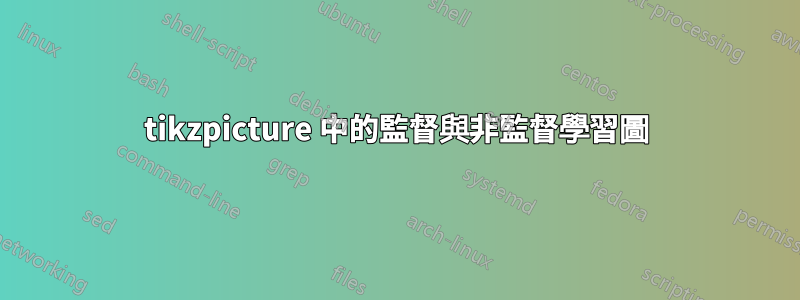
我想使用 來表示這兩張圖tikzpicture。我不需要將它們連接在一起,如下所示,但我想要類似的東西。
我可以產生如下散佈圖:
我有兩個獨特/不同的集群。我想在監督學習範例中繪製線性可分線,同時在無監督學習範例中繪製聚類。
此外,擁有顏色/更大的點會很棒。
代碼:
\documentclass{article}
\usepackage{pgfplots}
\begin{document}
\begin{tikzpicture}
\begin{axis}[%
axis lines = left,
xlabel = x,
ylabel = y,
]
\addplot[only marks] table [%
x = x,
y = y,
col sep = comma]{
x, y
%cluster 1
2, 3
3, 5
4, 5
3, 8
5, 9
3, 2
5, 6
6, 6
7, 9
10, 4
11, 5
9, 4
%cluser 2
20, 10
21, 12
24, 12
25, 13
27, 14
22, 13
23, 15
25, 10
15, 14
};
\end{axis}
\end{tikzpicture}
\end{document}
答案1
您可以使用scatter/classes不同的方式格式化兩個簇中的點,但將其分成兩個更容易\addplot。要設定格式,請使用 eg \addplot [blue, only marks, mark=*, mark size=5] ...,我想這大多是不言自明的。
對於直線和圓,這幾乎只是使用普通 TikZ 指令的情況。請注意,預設情況下,如果您在環境\draw (x,y) ..內部執行此操作axis,x並且y不在axis.除非您可以a)使用(axis cs:x,y),或b)添加\pgfplotsset{compat=1.11}(或更高的版本號),在這種情況下axis cs成為預設版本。
進一步注意, acircle[radius=2]內部axis需要compat=1.11(我認為),但半徑再次位於軸座標中,因此在這種情況下它將變成橢圓形。您可以做的是在 內部定義一個座標axis,並在其外部繪製圓形。兩者都在下面的程式碼中進行了演示。
\documentclass{article}
\usepackage{pgfplots}
\pgfplotsset{compat=1.11} % <-- added
\begin{document}
\begin{tikzpicture}
\begin{axis}[%
axis lines = left,
xlabel = $x$,
ylabel = $y$,
clip mode=individual % so things drawn by \draw and similar are not cut off
]
\addplot [blue, only marks, mark=*, mark size=5] table [%
x = x,
y = y,
col sep = comma]{
x, y
%cluster 1
2, 3
3, 5
4, 5
3, 8
5, 9
3, 2
5, 6
6, 6
7, 9
10, 4
11, 5
9, 4
};
\addplot+[red, only marks, mark=*, mark size=5] table [%
x = x,
y = y,
col sep = comma]{
x, y
20, 10
21, 12
24, 12
25, 13
27, 14
22, 13
23, 15
25, 10
15, 14
};
% to be able to use axis coordinates with \draw directly you need
% \pgfplotsset{compat=1.11} or a higher version
% if that is not present, use (axis cs:4,14) instead of (4,14),
% to specify that the values should be interpreted as axis coordinates
\draw [dashed] (4,14) -- (25,2);
% save a coordinate for use later
\coordinate (c2) at (23,12);
% the blue circle is drawn inside the axis environment, and in axis coordinates
% hence it becomes an ellipse
\draw [blue, dashed] (6,6) circle[radius=5];
\end{axis}
% the red circle is drawn outside the axis, so actually looks like a circle,
% but the radius has no relation to the axis coordinates
\draw [red, dashed] (c2) circle[radius=2cm];
\end{tikzpicture}
\end{document}
兩軸
有多種方法可以使兩個圖彼此相鄰。您可以tikzpicture一個接一個地添加兩個 s,或者您可以axis在同一個環境中有兩個環境tikzpicture,並將第二個環境放在\begin{axis}[at={(x,y)},....就我個人而言,我喜歡圖書館groupplot的環境groupplots,它用於製作軸網格。
\documentclass{article}
\usepackage{pgfplots}
\usepgfplotslibrary{groupplots}
\pgfplotsset{compat=1.11}
\begin{document}
\begin{tikzpicture}
\begin{groupplot}[
group style={
group size=2 by 1,
horizontal sep=1.5cm
},
axis lines = left,
xlabel = $x$,
ylabel = $y$,
width=5cm, % <-- set size of axes
clip mode=individual, % to avoid \draws being cut off
title style={yshift=1mm, font=\bfseries\sffamily}
]
\nextgroupplot[title=Supervised learning]
\addplot [blue, only marks, mark=*, mark size=3] table [%
x = x,
y = y,
col sep = comma]{
x, y
%cluster 1
2, 3
3, 5
4, 5
3, 8
5, 9
3, 2
5, 6
6, 6
7, 9
10, 4
11, 5
9, 4
};
\addplot+[red, only marks, mark=*, mark size=3] table [%
x = x,
y = y,
col sep = comma]{
x, y
20, 10
21, 12
24, 12
25, 13
27, 14
22, 13
23, 15
25, 10
15, 14
};
% to be able to use axis coordinates with \draw directly you need
% \pgfplotsset{compat=1.11} or a higher version
% if that is not present, use (axis cs:4,14) instead of (4,14),
% to specify that the values should be interpreted as axis coordinates
\draw [dashed] (4,14) -- (25,2);
\nextgroupplot[title=Unsupervised learning]
\addplot [blue, only marks, mark=*, mark size=3] table [%
x = x,
y = y,
col sep = comma]{
x, y
%cluster 1
2, 3
3, 5
4, 5
3, 8
5, 9
3, 2
5, 6
6, 6
7, 9
10, 4
11, 5
9, 4
};
\addplot+[red, only marks, mark=*, mark size=3] table [%
x = x,
y = y,
col sep = comma]{
x, y
20, 10
21, 12
24, 12
25, 13
27, 14
22, 13
23, 15
25, 10
15, 14
};
% save a coordinate for use later
\coordinate (c2) at (23,12);
% the blue circle is drawn inside the axis environment, and in axis coordinates
% hence it becomes an ellipse
\draw [blue, dashed] (6,6) circle[radius=5];
\end{groupplot}
% the red circle is drawn outside the axis, so actually looks like a circle,
% but the radius has no relation to the axis coordinates
\draw [red, dashed] (c2) circle[radius=1cm];
\end{tikzpicture}
\end{document}






